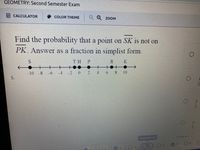
Elementary Geometry For College Students, 7e
7th Edition
ISBN: 9781337614085
Author: Alexander, Daniel C.; Koeberlein, Geralyn M.
Publisher: Cengage,
expand_more
expand_more
format_list_bulleted
Concept explainers
Topic Video
Question

Transcribed Image Text:**Geometry: Second Semester Exam**
**Question 5:**
Find the probability that a point on \( \overline{SK} \) is not on \( \overline{PK} \). Answer as a fraction in simplest form.
**Diagram Explanation:**
The diagram is a number line with labeled points:
- \( S \) at -10
- \( T \) at -2
- \( H \) at 0
- \( P \) at 4
- \( R \) at 8
- \( K \) at 10
The number line goes from -10 to 10 with the points \( S \), \( T \), \( H \), \( P \), \( R \), and \( K \) marked as indicated. You are asked to find the probability that a random point chosen on the line segment \( \overline{SK} \) (from \( S \) at -10 to \( K \) at 10) does not lie on \( \overline{PK} \) (from \( P \) at 4 to \( K \) at 10).
To solve the problem:
1. Calculate the total length of \( \overline{SK} \).
2. Calculate the length of \( \overline{PK} \).
3. Subtract the length of \( \overline{PK} \) from the total length of \( \overline{SK} \) to find the length that is not on \( \overline{PK} \).
4. Find the probability by dividing the length not on \( \overline{PK} \) by the total length of \( \overline{SK} \).
Calculation steps:
1. Length of \( \overline{SK} \) = \( K - S = 10 - (-10) = 20 \)
2. Length of \( \overline{PK} \) = \( K - P = 10 - 4 = 6 \)
3. Length not on \( \overline{PK} \) = \( 20 - 6 = 14 \)
Probability = \( \frac{14}{20} = \frac{7}{10} \)
So, the probability that a point on \( \overline{SK} \) is not on \( \overline{PK} \) is \( \frac{7}{10} \).
Expert Solution
This question has been solved!
Explore an expertly crafted, step-by-step solution for a thorough understanding of key concepts.
This is a popular solution
Trending nowThis is a popular solution!
Step by stepSolved in 2 steps with 2 images

Knowledge Booster
Learn more about
Need a deep-dive on the concept behind this application? Look no further. Learn more about this topic, geometry and related others by exploring similar questions and additional content below.Similar questions
arrow_back_ios
arrow_forward_ios
Recommended textbooks for you
 Elementary Geometry For College Students, 7eGeometryISBN:9781337614085Author:Alexander, Daniel C.; Koeberlein, Geralyn M.Publisher:Cengage,
Elementary Geometry For College Students, 7eGeometryISBN:9781337614085Author:Alexander, Daniel C.; Koeberlein, Geralyn M.Publisher:Cengage, Elementary Geometry for College StudentsGeometryISBN:9781285195698Author:Daniel C. Alexander, Geralyn M. KoeberleinPublisher:Cengage Learning
Elementary Geometry for College StudentsGeometryISBN:9781285195698Author:Daniel C. Alexander, Geralyn M. KoeberleinPublisher:Cengage Learning

Elementary Geometry For College Students, 7e
Geometry
ISBN:9781337614085
Author:Alexander, Daniel C.; Koeberlein, Geralyn M.
Publisher:Cengage,

Elementary Geometry for College Students
Geometry
ISBN:9781285195698
Author:Daniel C. Alexander, Geralyn M. Koeberlein
Publisher:Cengage Learning